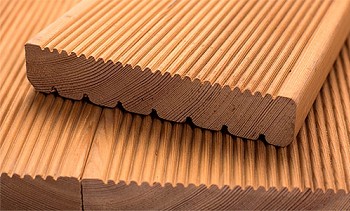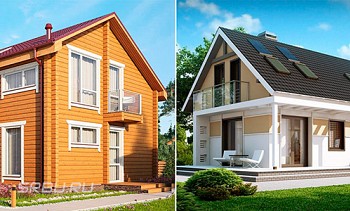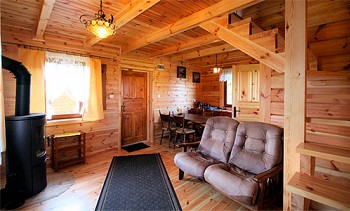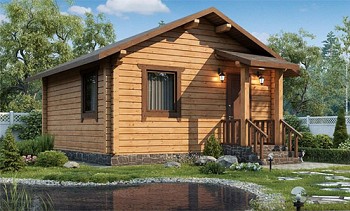A variety of methods of using wood for interior and exterior decoration determines the presence on the market of a large number of materials necessary for this, each of which in turn is divided into varieties, varieties and classes. Types of lining, thin planed boards for surface lining, for a domestic buyer, are primarily divided into ordinary and euro. The further choice depends on the need to use coniferous or deciduous boards, which profile shape will be better, as well as the price / quality ratio, which is determined by the type of wood.
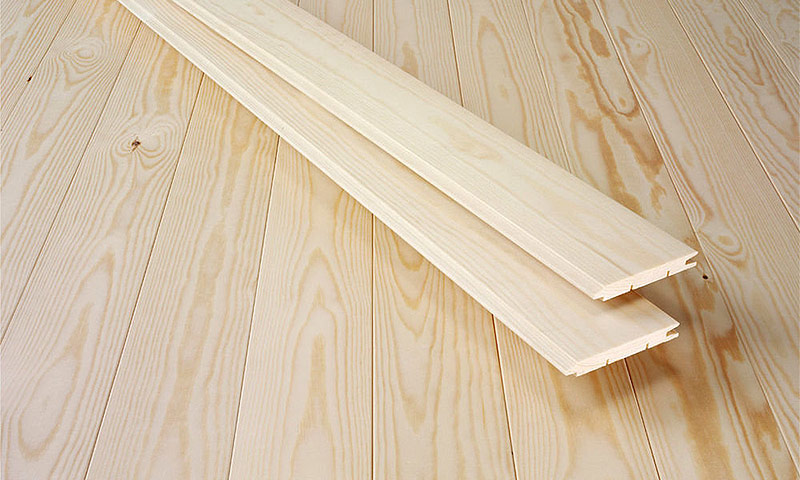
Content:
Normal and euro lining
The name of the lining is due to the need to save loads from the sun and rain that were transported by rail until the introduction of modern materials. The use of wood for lining cars was the most appropriate, since it is not only cheaper than iron, but also better prevents the greenhouse effect. Initially, the boards were fastened in the usual way, but over time, in order to simplify installation and prevent the appearance of cracks, in the event of any deformation, they began to be made with spike-groove locks. The idea was appreciated and such boards began to be widely used in facing works.
In other languages there is no such link to the origin of the name, so when visiting foreign construction stores you just need to look for profiled boards. For their manufacture, the standard DIN 68126/86 is used, developed in Europe and, according to a number of requirements, is more stringent than local GOST. Accordingly, exported products, or simply manufactured according to DIN standards, are familiar to the domestic buyer as eurolining.
Builders present a large number of claims to the usual lining, made even according to Soviet standards, both in terms of characteristics and ease of installation. Humidity of 20-25% is too high - with a board thickness of 20 mm during drying, deformations often occur that small locks cannot cope with, trying to jump out of the groove. The fleecy surface and the number of knots, which are not particularly controlled, make not only the shape unimportant, but also the quality of such products.

Profile of a standard lining made in accordance with GOST.
As a result, euro lining, despite the price, is much more readily used by builders due to its advantages:
- A more thought-out form: a large tenon is not afraid of deformations, the optimal thickness and width of the lamellas (12.5 and 88 (excluding the tenon, with it 96) mm, respectively), the presence of ventilation grooves, the ability to select a profile picture.
- Pile on the front side is not allowed, thorough processing of the tongue-and-groove lock for ease of installation.
- The entire lining is dried to a moisture content of 10-15%, which negates the possibility of its deformation and the likelihood of bugs or rot. Dry boards are easier to store, handle and care for during use.
- After sawing wood, boards, depending on quality, are divided into at least four grades, taking into account manufacturing defects and the condition of the wood itself.
Types of lining profiles
Since the lining is used for cladding many surfaces, manufacturers take into account the wishes of customers to give their premises a certain personality and produce several varieties of profiles that can be selected not only in appearance, but also for certain types of work. Profiles differ from each other by the presence or absence of chamfers, the types of locks, the shape and size of the front and back sides.
Traditional euro lining
An additional chamfer is selected on the front side of such a profile near the spike, as a result of which pronounced seams are visible after mounting on the wall. The chamfer can be angular or rounded. The rounded one is called Softline.


Lining "Softline"
Since this surface shape is devoid of corners, there is less likelihood of chips and burrs during operation, therefore Softline are considered more suitable for rooms such as a sauna.


Lining "Calm"
The difference between this profile is the absence of a chamfer near the tenon, so the seams after installation are not as pronounced as when using traditional lining. If necessary, they use this to create an imitation of a wall assembled from timber, so most of the Calm lining is produced thickened to 25 mm and can be freely used for cladding building facades.


Lining "Landhouse"
The lamellas, which include such types of wooden lining, are one of the most expensive, since during their production the front side is subjected to milling or other processing methods, which form complex patterns on the surface of the wood. There are even wood carving profiles that are produced using hot stamping under the press.


Lining "Blockhouse"
If the “Calm” lining imitates walls made of timber, the “Blockhouse” profile has a completely rounded front part. Thanks to this decision, after assembly, the wall looks as if the house was assembled from logs. It is mainly used for cladding building facades.


Lining "American"
In this profile, not only the chamfer near the spike is removed, but a smooth transition is made from it to the middle of the front part. Thanks to this solution, an exact imitation of siding panels is achieved, but at the same time the house is lined with natural wood.


Double-sided lining
This profile has no back side - both of its parts are made front. Such a lining is useful if necessary to make a thin wooden partition. Also, when facing the wall, it is possible to choose a more successful pattern or to place small defects on the back side.
This lining is not recommended for use in rooms with high and variable humidity, as it is the only one of all types of eurolining that does not have compensation (ventilation) channels.

Varieties of lining
Unlike other materials, which are processed differently depending on their cost, the entire lining is made by the same methods, in one batch and passes through the same machines. Fully finished boards are sorted depending on the presence of cracks, knots, tar pockets, poorly worked areas (uneasy) and pronounced blue, which is a consequence of improper drying of the tree.
Also, when buying a lining, it is necessary to take into account such an unpleasant moment that each of the manufacturers can sort the products based on different GOSTs, or even develop their own technical conditions. As a result, if there is no confidence in the products of a particular manufacturer, then it makes sense to double-check at least some of the boards before purchasing them.
Extra
Additional names - "knotless" or "premium". Even small uneasy and cracks on the front side are unacceptable, therefore, such a profile does not need additional processing. On a running meter it is allowed to have one healthy light knot, but without cracks and other defects near it. In the presence of opened resin pockets, the resin is removed, and the site itself is putty and cleaned with fine sandpaper.
Class A
In such profiles, the presence of 2-3 knots per linear meter of the product and small chips near them is allowed. On the front part there may be small uncomplicated and microcracks (depending on the manufacturer - putty). End cracks are also permitted, but no larger than the width of the board. Profiles made from the core should not exceed 20% of all boards in the package.If the boards are made of coniferous wood, then slight tarring is allowed - no more than 10% of the total. The general coloring can vary on small sections of boards (up to 10%) for every tenth of them in a package.
Class B
On one board, two drop knots are allowed, as well as cracks on the front surface up to 300 mm long and end ones. On the edges of the board are allowed knots with a diameter of not more than 20 mm. Boards can be from the core and with resin pockets. If they are made of coniferous species, surface salinity is allowed. In three places on one board, places affected by insects are allowed, but not more than 5% of the total number of boards. Inadequate coloring is allowed except blue and uneasy if they do not affect the build quality.
Class C
This class includes all boards that did not fall into higher categories and which can be used for their intended purpose. The use of rotten boards is clearly prohibited, but there are no restrictions on all other parameters. In such profiles, there may be holes from knots with a diameter of more than two centimeters, through cracks and resin pockets, pickles and sprouts, insect-affected areas, and color mismatch. Uncomplicated and other defects are also not limited, unless they affect the stability of the surface. By the size of the board, any grade is made according to the following tolerances: length ± 50 mm, width ± 1 mm and thickness ± 0.5 mm.
 |  |  | |||||||
|---|---|---|---|---|---|---|---|---|---|
| Class A | Class B | Class C | |||||||
| Knots | Acceptable: knots without cracks, no more than 2-3 pieces per 1 meter of the board; cracks and chips on knots from the crest and from the groove on the lower edge, which are invisible when assembled. | Dropdowns with a diameter of up to 20 mm and falling out with a diameter of 20 mm are permissible - no more than 2 pcs per meter of board. | Allowed knots with a diameter of more than 20 mm. | ||||||
| Cracks | Acceptable: end-face-sized boards and microcracks. | Valid end sizes of 300 mm. in the direction of the fibers. | Valid. | ||||||
| Core | Permissible size of not more than half of the board in 20% of the boards from the package. | Valid | Valid | ||||||
| Wood wood | Valid in small quantities. | Valid if it will not affect the assembly. | Valid | ||||||
| Resin pockets | Permissible diameter of not more than 6 mm, 2 pcs. on the length of the board. | Valid. | Valid. | ||||||
| Tarred areas | Acceptable not very tarred areas in 10% of the boards from the package. | Valid. | Valid. | ||||||
| Spree | Allowed no more than half the width of the boards. | Valid | Valid | ||||||
| Insect damage | Not valid. | Allowed no more than 3 pcs. on the length of the board in 5% of the boards from the package. | Allowed. | ||||||
| Rot sites | Not valid. | Not valid. | Not valid. | ||||||
| Color difference | Valid for 10% of boards on 10% of the board area. Blue is not acceptable. |
Valid stripes. Blue is unacceptable. |
Allowed. | ||||||
| Processing quality | Small roughnesses and grooves at the edge in the area of knots are permissible. | Permitted gouging defects do not affect the assembly. | Permissible gouging defects do not impair the quality of the finish. | ||||||
Types of lining depending on the species of wood
Any kind of wood is used for the production of lining. The choice between them depends on the necessary characteristics that I would like to see on the treated surface, the types of lining for interior decoration or exterior work, as well as the budget that can be allocated for its purchase, are selected. The main division is on the boards obtained from coniferous and deciduous species of wood.
Conifers
It is characterized by the presence of essential oils and resins, which put a natural barrier to moisture and various fungi, so this lining is most often chosen for use in outdoor decoration. They are also faced with walls in baths and steam rooms, but for this, the boards undergo a careful selection and the process of demineralization. Lining from needles favorably differs in the big term of operation which can make several decades.
Spruce. Due to the natural softness of this tree, it is more often used to obtain lining with rounded shapes. Designers often recommend this material for interior decoration, the design of which is made in any of the modern styles.
Of the physical characteristics, a low roughness indicator and a beautiful surface texture without pronounced patterns stand out.
Due to the relatively low cost and strength properties, such wood is widely used in exterior and interior decoration. However, one should take into account the high level of hygroscopicity of spruce boards - to increase the service life they must be treated with appropriate chemicals.
Pine. This lining can be considered the most budgetary decision among all coniferous species, which, however, does not detract from its characteristics regarding the appearance of the boards and their strength.
The pine lining has only two significant drawbacks that you should pay attention to before buying:
- The low density of wood, which although reduces the overall weight of the coating, but makes it vulnerable to scratches and similar damage.
- Pine boards, even appropriately processed, emit tar drops for a long time, which is especially unpleasant when used for decoration in a bathhouse. If you lean against tarred wood in the steam room, it is almost a guaranteed burn.
Larch. The only drawback that can be found with such a coating is its high cost, which is quite determined by its quality.
Among the advantages, first of all, the strength of this wood, which is not only high in itself, stands out, but also increases with time, by about a third exceeding the performance of boards made from the rest of conifers.
The characteristic structure of larch not only determines the beauty of the boards, but also gives them exceptional thermal insulation properties. The resin contained in the wood fibers is a natural barrier, protecting it from moisture and insect pests, and also maintains a natural reddish tint that looks great on any surface throughout its life.
Cedar. The natural impregnation of cedar planks with resins gives them a strong characteristic coniferous smell that has a beneficial effect on the human body, and in particular on the nervous system.
Cedar lining is an excellent heat insulator, and also due to its high density has high resistance to mechanical damage. Subject to proper processing, cedar boards retain all their properties for several decades, which allows them to be used both in interior and exterior decoration.
An additional “bonus” that owners of rooms decorated with cedar lining receive is the absence of mosquitoes who do not like the smell of this tree.

Lining from pine.
Hardwood
Since there are no resins and other volatile substances in the composition, these types of lining are mainly used for interior decoration, including rooms in saunas and baths. A common drawback of such materials is their lower durability, but this is often compensated by low thermal conductivity, which allows them to be used in rooms heated to high temperatures.
Linden. It has a relatively low cost, exceptional resistance to mechanical damage, deformation and moisture, which makes products from this tree an ideal solution for use in bathhouses or for decorating balconies.
A significant drawback of such a lining is that it darkens noticeably over time, therefore linden boards necessarily require additional treatment with impregnations to prevent rotting of the tree.
Alder. When heating boards from alder, they release into the air volatile compounds obtained from tannins contained in a tree.In addition to the fact that the nature of these compounds has a beneficial effect on the human body, the tree itself does not absorb moisture, which is why it is successfully used in the decoration of rooms in which high air humidity is assumed.
Other advantages of the material include low thermal conductivity, high soundproofing properties and a characteristic coloring, due to which the alder is easily recognizable when used as a finishing material.
The disadvantage that will have to be circumvented is the relatively low service life, which is corrected by the use of protective compounds.
Oak. Products from this tree were and remain an elite “classic of the genre”, characterized by unsurpassed quality and corresponding value.
High strength characteristics affect not only the further operation of the products, but also the processing cost, which also adds up to their price for the end customer. Also, the prices for an oak lining strongly depend on its length, and for facing the rooms in the bathhouse, designers just recommend choosing long and narrow boards that will create a more holistic picture.

Lining from linden.
Valuable, exotic breeds
Most often, exotic refers to products made of mahogany. Since the habitat for it is exclusively tropical forests, such products are rare on the domestic market and the cost is quite high. Despite the good physical characteristics, such wood is suitable for all types of processing, and the size of tree trunks allows you to get a lining of almost any size. It is mainly used for interior decoration.
Dimensions of wooden lining
For various purposes, a lining with a certain length, thickness and width may be needed, but this is not a noticeable problem, since it is produced in many sizes, and in general it is sold in lengths from boards from 0.3 to 6 meters in increments of 10 cm .
It must be borne in mind that the wider the lining, the greater the likelihood of its deformation with changes in temperature or humidity. Accordingly, narrower boards better withstand geometry, and also have greater resistance to shock loads and other mechanical stresses. A certain decorative effect can be achieved by randomly installing boards of different widths. This installation method has almost no effect on the strength of the resulting surface.
In thickness, the optimal option for internal work is a lining with a size of 12.5 mm - this is the calculated optimal ratio of weight and strength. If you use a lining for outdoor work, it is better to select a thickness already within 15-20 mm, although it will come out more expensive - such lamellas are capable of supporting not only their weight, but also a sufficiently thick layer of insulation materials.
A long lining is not necessarily made from a single piece of wood - the method of splicing boards along the length is often used when pieces of size 150-750 mm are connected into one lamella. Docking is done on a microchip, and the joint itself is additionally glued and is kept under pressure until the glue dries.
The disadvantages of spliced lamellas are more related to their use in interior decoration:
- Splicing technology does not allow a board to be thinner than 15 mm, which affects its weight and cost.
- There is no way to find out what glue was used in production and whether it will emit harmful substances when heated - this factor often prevents consumers who are going to build a bathhouse from buying.
The advantage of lining made by this method is the absence of internal mechanical stresses of the material. The total length of these lamellas is up to 6 meters, and by grade they can even belong to the Extra class.
As a result, from the listed varieties and characteristics of lining, it is clear that the range of this material offered on the market can fully satisfy the needs of any buyer: in quality, quantity and cost.

